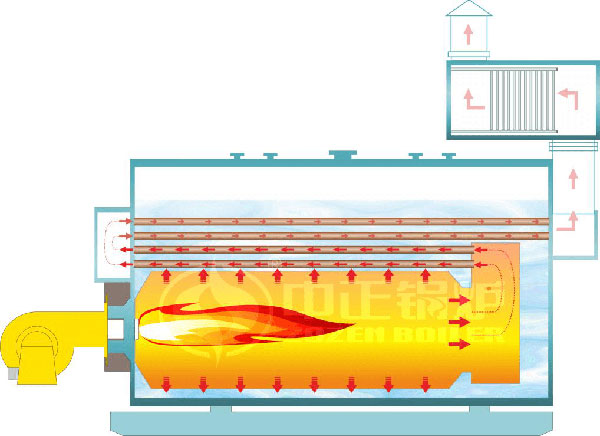 sales@zozen.com
sales@zozen.com
- WhatsApp: 0086-18861589035
-
The second pass of the gas boiler is that the flue gas flows out of the boiler body after two return passes in the boiler body. The first return is the torch formed after the fuel is burned by the burner, which is filled in the full-wave furnace and transmits radiant heat through the furnace wall. The corrugated furnace combustion chamber transmits the radiant heat through the furnace wall. The second return is generated by combustion. After the high-temperature flue gas converges on the first return journey, it turns to the tube bundle area. After convection heat exchange, the flue gas temperature gradually decreases to the front smoke box and exits the boiler body.

Schematic diagram of three-pass boiler

Schematic diagram of tw-poass boiler
The three-pass gas boiler adds a tube bundle area on the basis of the second return, and leaves the body after another round of heat exchange. The following is a list of the specific differences between three-pass and two-pass gas boilers.
1. In terms of structure, the three-pass gas boiler has one more heat exchange area than the two-pass gas boiler, the smoke outlet is at the other end of the burner, and the second-pass gas boiler smoke outlet is at one end of the boiler burner.
2. In the system, an economizer is added to the tail of the three-pass gas boiler to further absorb the flue gas temperature and reduce the exhaust gas temperature. The two-pass gas boiler is equipped with an economizer and a condenser, the heat absorption surface is larger, and the exhaust gas temperature is lower.
3. In terms of cost, the boiler body has more tube bundles for three-pass gas boilers and uses more materials than two-pass gas boilers. However, two-pass gas boilers have more stretch rods (fixed function) than three-pass gas boilers, which may be several thousand yuan. However, the two-pass gas boiler has more condenser costs than the three-pass gas boiler.
4. In terms of performance, the thermal efficiency of the three-pass and two-pass gas boilers is relatively high. Although the three-pass gas boiler transfers heat energy through three return passes, an extra condenser is added to the tail of the two-pass gas boiler flue gas. If a condenser is added to the tail of the three-pass gas boiler, the resistance of the boiler will increase, the power consumption will increase, and the cost will not be proportional to the performance.
It is worth noting that there is also a multi-pass boiler on the market, which includes condensers and economizers, so two-pass gas boilers with condensers and economizers can also be called four-pass gas boilers. Similarly, a three-pass boiler can also become a four-pass gas boiler.
To sum up, there is little difference in performance between the three-pass and two-pass gas boilers. As long as they can meet the requirements of enterprise efficiency and smoke exhaust, both can be used. The three-pass and two-pass gas boilers produced by Wuxi ZOZEN Boiler have higher applications in various industries. The thermal efficiency can reach more than 98%, and the environmental protection performance also meets the national standards. If you have any needs, please contact the manual customer service online or WhatsApp +8613506151292 directly.

I want to comment